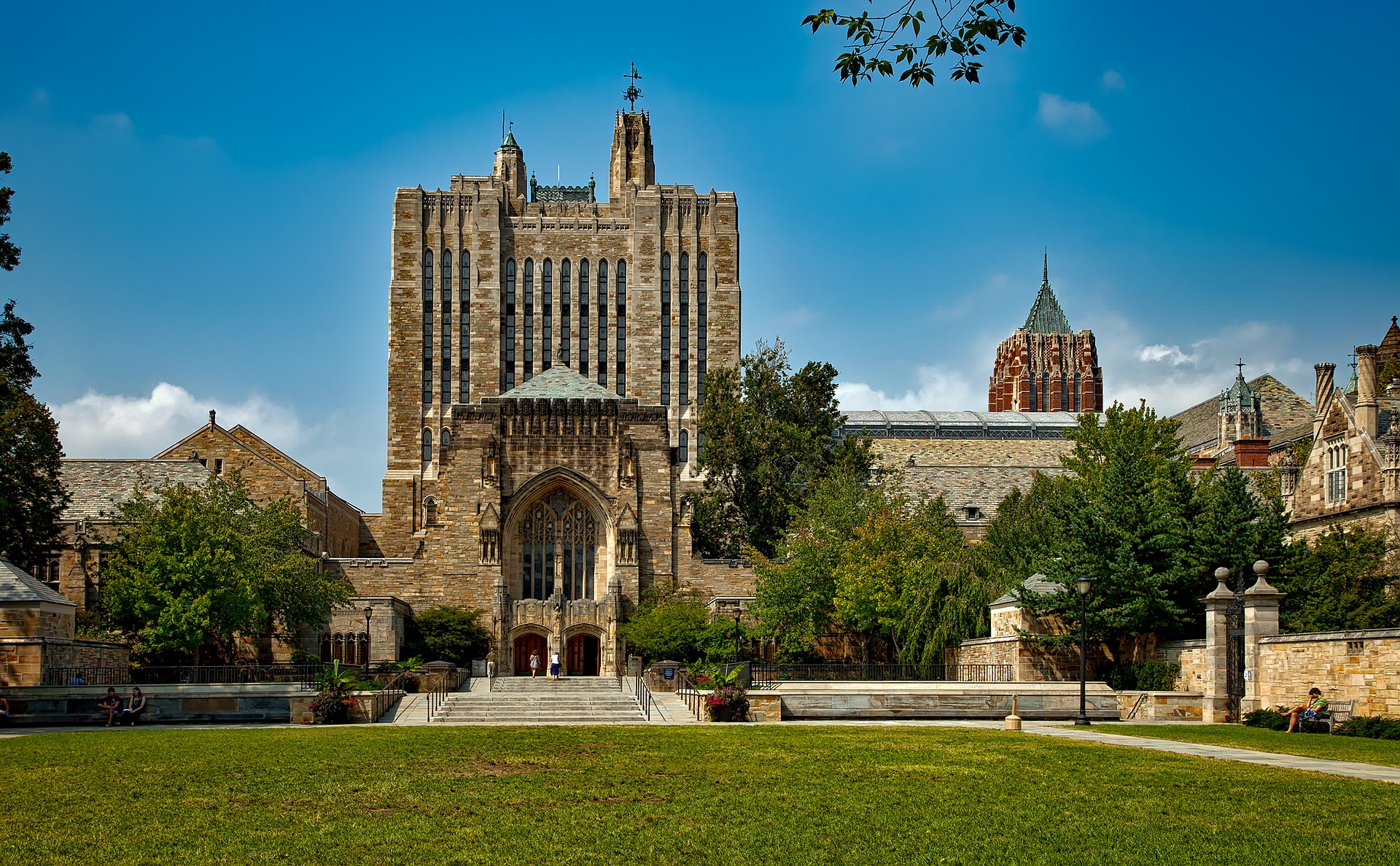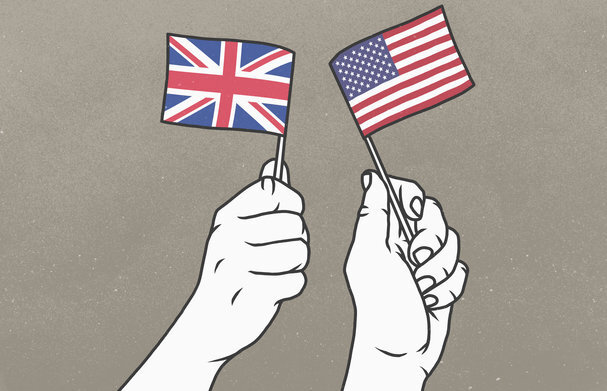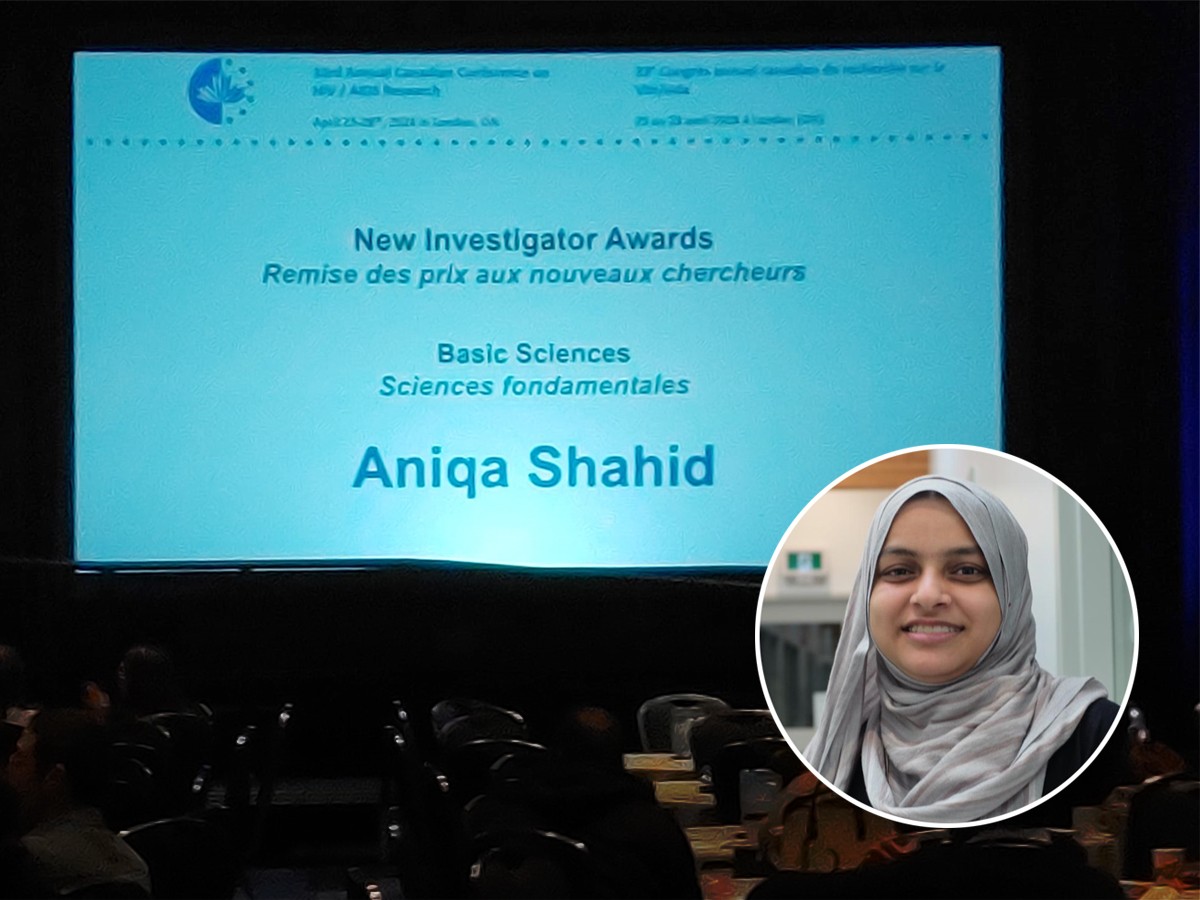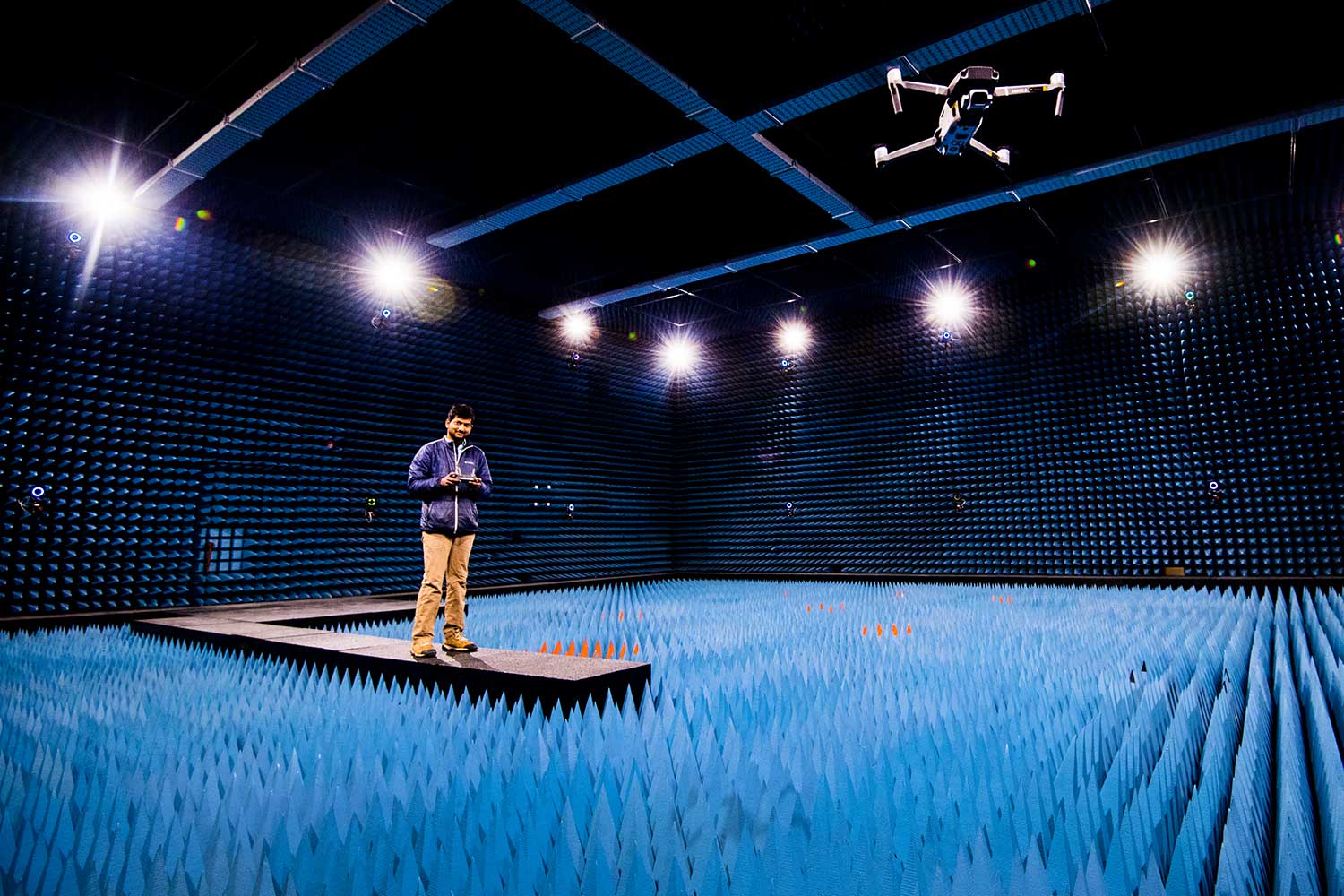Canada vs. the U.S.: where should you attend grad school?
An exploration of some of the nuances between postsecondary education in the two countries, as well as some of the intangibles that are often not thought about.
- One comment
So you’ve decided to pursue graduate school , and as you do a deeper dive into the different program websites, you will likely start to take note of some features: institution and program size, cost, location, application and program requirements, and potential supervisors (or advisors as they are typically referred to in the U.S.).
What might be missing from this picture are some of the nuances in these concrete details, as well as some of the intangibles, such as what your experience might be like during and after graduation. The U.S. remains a popular choice, although some suggest there has been a decline in interest, based on a Council of Graduate Schools survey showing a four percent decline in international student graduate applications between fall 2017 and fall 2018. Canada, meanwhile, has become increasingly popular ( Statistics Canada reported that enrolment in public colleges and universities was up 1.2 percent in 2016-2017, with the number of international students increasing at a higher rate than that of Canadian students). With this in mind, it’s worth teasing out some of the less easily discernible differences between studying in these two countries.

Funding for your master’s or doctoral studies
The tuition differences between local/domestic residents versus international students in Canada, or in-state versus out-of-state and international fees in the U.S. may be substantial. For example, at McGill University , if you are a Quebec resident, then the tuition and fees for a full-time master’s program is ~$4,430 (CAD) for the fall and winter terms. For a non-Quebec Canadian, it would cost ~$9,826 (CAD), and for international students, it would be a little over ~$20,000 (CAD). In the U.S., at a well-regarded public institution like University of California, Los Angeles (UCLA), one year’s tuition and fees for California residents are ~$16,847 (USD), and ~$31,949 for non-California residents. At a private university like Stanford, the tuition alone for the academic year is estimated to be ~$34,110 (USD).
But the “sticker price” versus what you end up paying may, in fact, vary. At the doctoral level, some elite institutions in the U.S. are able to provide their students with full funding for the duration or a significant portion of their studies. Even in circumstances where the tuition is high, it is not unusual for both American and Canadian graduate programs to help identify opportunities for teaching assistant (TA) or research assistant (RA) work. However, you would be well-served to inquire how long you would be eligible for any tuition waivers (find out when does it would time out), if there are ample TA or RA positions, and what other fellowships or funding sources that you could apply to for support (find out the success rate). For example, in Canada, there may be fellowships/funding awards that are limited to Canadian citizens, but there are also generous (though highly competitive ) sources of funding that accept applications regardless of residency status.
Is a master’s degree required for entry into a doctoral program?
One difference that might already be on your radar is that GRE tests are often required for graduate programs in the U.S., whereas this is not generally the case in Canada. Another difference that may not always be obvious is that in the Canadian context, doctoral programs will often require that you have a master’s degree to gain entry; in the U.S., it is not always necessary. One reason is because doctoral programs in the U.S. might include more coursework that could overlap with the requirements for a master’s degree. In Canada though, some programs may have a fast-track option to the PhD degree after the first year of the master’s program. The lack of a master’s degree requirement in certain doctoral programs in the U.S. might also coincide with the granting of a “masters-en-route” after one meets certain program milestones. This kind of degree can be advantageous for those who want an extra credential as they pursue their doctorate, or may be useful should one leave the doctoral program without completing the dissertation.
Campus and community life
The location of a university can have an impact on its campus life and its relationship to the surrounding community. If you are in a town whose population swells with the start of the academic year (e.g., Ann Arbor, Michigan or Kingston, Ontario) versus a bustling metropolis (e.g., Chicago or Montreal), the campus culture and its relationship to the surrounding area will feel different. By virtue of the sheer number of universities in the U.S., you might find many public institutions to be in suburban or rural settings, which creates campuses that are likely more self-contained than ones in big cities. While this may not rank as high in your decision making process as cost/funding, alumni outcomes, supportive faculty, or curriculum, try to get a feel for your life and community both inside and outside of the program.
Some other things to ponder during your institution exploration:
- Does your department you’re applying to create opportunities for exchange and support amongst peers?
- Are there research centres that you can lean on for professional development and networking?
- Does campus culture revolve around sports?
- Is the university more likely to support an “alternative spring break” where you donate your time to a community organization?
- Do eating clubs or fraternities and sororities play a significant role in social life?
Career prospects in your industry
If you are not a Canadian or U.S. citizen, and you are hoping that a master’s or doctoral degree might enable you to work in your industry, you need to find out the work permit or residency process once you graduate. It has been argued that Canada’s immigration policy might play a role in increasing international student enrolment, but will you need to learn another language to be competitive? How might location play a role in terms of whether your partner can find meaningful work? How could your university’s reputation and network be put to your advantage? What does the university offer in terms of skills development and career planning so that you can launch your career after graduation?

Cancel reply
Your email address will not be published. Required fields are marked *
Save my name, email, and website in this browser for the next time I comment.
Confused by this article because a number of the differences that are alluded to are simply not true. It is not at all uncommon for Canadian universities to offer full, multi-year guaranteed funding for full-time Ph.D. students – just like in the US. The article also suggests that there are no direct-entry Ph.D. programs in Canada – which is incorrect. As in the US, direct-entry programs are more common in some discipline areas than in others – but if excellent undergraduate students are looking for a direct entry into a doctorate should look in Canada as well as the U.S.
There are, of course, differences between graduate education between Canada and the United States – in some program areas, for example, doctoral students are expected to complete more coursework in the United States than in peer Canadian universities. More importantly, there are major differences between programs by institution in both countries – so the best advice is to spend time searching out the best programs (and the best possible supervisors) in both countries and look for the very best matches given the research interests of the student and the strengths of the various programs.
Popular Searches
- Study Overseas
Pursue PhD in Canada: Make a Difference in Research
Updated On Feb 12, 2024

Share on Whatsapp
Share on Email
Share on Linkedin

Limited-time offer : Access a free 10-Day IELTS study plan curated for you
Table of Contents [ Show ]
Why Study Ph.D. in Canada?
Overview of ph.d. programs in canada, list of top 5 universities to pursue phd programs in canada, eligibility criteria & admission requirements to study phd in canada, cost of studying phd in canada for international students, top 5 ph.d. scholarships in canada for international students, job opportunities after pursuing ph.d. in canada.
Did you know every year, Canada welcomes over 80,000 international students eager to dive into the world of cutting-edge research and pursue their PhD dreams? With world-renowned universities, groundbreaking innovation, and a supportive research environment, Canada has become a magnet for aspiring academics from around the globe.
But navigating the path to a Ph.D. in Canada can feel like trekking through an unfamiliar forest. Well, breathe easy, future Dr.! This comprehensive guide is your compass, ready to clear the path and lead you on a smooth journey to securing your PhD spot in Canada. Let’s begin!
The journey to a Ph.D. is about pushing boundaries, delving deep into your field, and making a splash in the world of knowledge. But where you choose to start on this exciting quest matters. Let's find out why Canada is your ideal destination for pursuing a PhD program.
- Canada ranks 13th in the Global Innovation Index 2023 , boasting top-notch research facilities and a collaborative environment.
- With 19 universities among the top 200 in QS World University Rankings 2024 , Canada boasts a stellar track record of producing research superstars.
- With over $4 billion invested in health research annually , Canada offers generous funding opportunities for qualified PhD students.
- Completing your PhD grants you valuable Canadian experience and opens doors to permanent residency , making it a strategic investment in your future career.
- With a 12% job growth rate predicted for clinical research professionals, and competitive salaries averaging over $65,000 per year , Canada offers rewarding opportunities to put your expertise to work.
Explore: Is It Worth Moving to Canada from India?
Canada stands as a beacon for pursuing a Doctor of Philosophy (Ph.D.) degree, offering a diverse range of programs across various disciplines. Here's a comprehensive overview of PhD programs in the Great White North.
Canada is home to world-renowned institutions that offer exceptional Ph.D. programs across diverse disciplines. Here are the top 5 universities known for their excellence in research and academic prowess.
1. University of Toronto

As Canada's leading institution, the University of Toronto consistently ranks among the top global universities. With a robust commitment to research, it provides a conducive environment for pursuing a PhD across a multitude of fields.
2. University of British Columbia (UBC)

The University of British Columbia is acclaimed for its innovative research and academic excellence. Its picturesque Vancouver campus attracts scholars from around the world. UBC offers a wide range of PhD programs with a focus on interdisciplinary research.
3. McGill University

Situated in the vibrant city of Montreal, McGill University is renowned for its research-intensive programs. With a diverse and inclusive academic community, McGill provides an excellent platform for pursuing a PhD with global recognition.
4. McMaster University

McMaster is known for its strong emphasis on research and discovery. Located in Hamilton, Ontario, McMaster offers a collaborative environment for doctoral candidates, fostering innovation and critical thinking.
5. University of Montreal

The University of Montreal, a French-language institution, is a hub for cutting-edge research. With a strong emphasis on interdisciplinary studies, it offers a dynamic platform for pursuing a Ph.D. in a vibrant academic setting.
Pursuing a Doctor of Philosophy (Ph.D.) in Canada is a rewarding endeavor, but it requires meeting specific eligibility criteria and fulfilling admission requirements. Here's a breakdown of what aspiring PhD candidates need to consider.
- Educational Qualifications: Candidates must hold a relevant master's degree from a recognized institution. Some programs may accept exceptional candidates with an outstanding bachelor's degree.
- Research Proposal: A well-crafted research proposal outlining your intended area of study is often a crucial part of the application. This should highlight your research goals, methodology, and expected contributions to the field.
- Academic Transcripts: Submit comprehensive academic transcripts from all previous institutions attended. These transcripts should demonstrate a strong academic record, particularly in relevant courses.
- Letters of Recommendation (LOR) : Provide letters of recommendation from professors or professionals who can attest to your academic and research capabilities. These letters should emphasize your potential for successful doctoral research.
- Language Proficiency: Demonstrate proficiency in English or French, depending on the language of instruction at your chosen institution. Most universities accept scores from language proficiency tests such as IELTS or TOEFL. (TOEFL - Overall 107/20, IELTS - Overall 7.5)
- CV/Resume: Submit a detailed curriculum vitae (CV) or resume highlighting your academic achievements, research experience, publications, and any relevant work experience.
- Statement of Purpose (SOP) : Craft a compelling Statement of Purpose detailing your motivation for pursuing a Ph.D., your research interests, and how the program aligns with your career goals.
- Entrance Exams: While not universally required, some programs may mandate standardized entrance exams, such as the Graduate Record Examination (GRE) or discipline-specific exams.
- Portfolio of Research Work: If applicable, include a portfolio showcasing your previous research work, publications, or projects. This can strengthen your application and demonstrate your research capabilities.
- Interview: Be prepared for an interview, either in-person or virtually, where you may discuss your research proposal, academic background, and motivation for pursuing a PhD.
- Proof of Financial Support: Some institutions may require proof of financial support to ensure you can cover your tuition and living expenses throughout the duration of your PhD program.
Note: It's crucial to carefully review the specific requirements of the chosen university and PhD program, as these may vary.
Understanding the comprehensive cost of studying for a PhD in Canada enables international students to plan their finances effectively. Here's a breakdown of the financial considerations.
1. Tuition Fees
Tuition fees for Ph.D. programs in Canada vary by institution and program. On average, international students can expect to pay between 8,000 CAD to 16,000 CAD per year. This cost is influenced by factors such as the university's reputation and the field of study.
2. Living Expenses
The cost of living in Canada also varies based on the city and lifestyle. As a general estimate, international students should budget around 15,000 CAD to 20,000 CAD per year for accommodation, food, transportation, and other personal expenses.
Dive into: Top Jobs in Canada for Indian Freshers in 2023
3. Health Insurance
International students are required to have health insurance coverage in Canada. The cost of health insurance varies, and international students should budget approximately 600 CAD to 1,000 CAD per year for this mandatory expense.
4. Books and Supplies
Ph.D. programs often entail additional expenses for books, research materials, and supplies. International students should allocate around 1,000 CAD to 2,000 CAD annually for these academic resources.
5. Miscellaneous Fees
Institutions may charge miscellaneous fees covering services like access to recreational facilities, student unions, and other campus resources. This can range from 500 CAD to 1,000 CAD per year.
Canada offers a plethora of prestigious scholarships for international PhD students. Here are some notable options that can pave the way for your doctoral journey
1. Ontario Trillium Scholarship (Western University)
Administered by Western University, this scholarship provides substantial financial support for international PhD students, covering tuition and living expenses.
Scholarship Amount: 40,000 CAD/year, renewable for up to 4 years.
2. University of Alberta Graduate Entrance Scholarships
A one-time award for outstanding international PhD candidates entering the University of Alberta. While not renewable, it provides a significant boost to initial finances.
Scholarship Amount: 21,000 CAD, cannot be renewed.
3. Doctoral Scholarship at the University of Montreal
Designed for doctoral candidates at the University of Montreal, this scholarship offers financial assistance for the first year, with the option for renewal for a second year.
Scholarship Amount: 7,000 CAD, renewable once.
Also, read: Best PhD Scholarships for Indian Students Abroad
4. 4-Year Doctoral Fellowship - University of British Columbia
This prestigious fellowship at the University of British Columbia supports international Ph.D. students with a substantial stipend and full coverage of tuition fees throughout the 4-year program.
Scholarship Amount: 18,200 CAD (annual stipend), covers full tuition fees for up to 4 years.
5. Graduate Entrance Scholarship - University of Windsor
Awarded to exceptional international PhD candidates entering the University of Windsor, this scholarship provides financial support for the first year, with the possibility of renewal for three additional years.
Scholarship Amount: 7,500 CAD, renewable for up to 4 years.
Note: Before applying, ensure you thoroughly review the specific eligibility criteria, application requirements, and renewal conditions for each scholarship.

Completing a Ph.D. in Canada not only signifies academic achievement but also opens doors to diverse and rewarding career opportunities. Here are some compelling job prospects for Ph.D. graduates in Canada.
Take off Your Dream Career in Canada with GetGIS
Starting a PhD journey in Canada is a transformative experience, offering academic excellence, diverse research opportunities, and a welcoming environment. Remember that thorough planning and guidance are essential for a successful academic and immigration journey. Navigating visa applications, work permits, and residency options can be complex. That's where GetGIS comes in.
GetGIS stands as a reliable partner in your quest for a seamless transition to Canada. Our dedicated team understands the nuances of the Canadian immigration landscape and is poised to guide you through every step. Don’t wait!
Book Your Free Consultation!
- Study Abroad
- Study in Canada
- Universities in Canada
- Career abroad
Frequently Asked Questions
Can I settle in Canada after PhD?
Are PhD fully funded in Canada?
Can I work full-time while doing a PhD in Canada?
Which PhD is most in demand in Canada?
How much is a PhD stipend in Canada?
Practice IELTS Speaking Based on other question types

Smruti Das ,
Content Marketing Specialist
Smruti is a passionate and highly skilled content writer working in this field for the past 2 years. She is known for her ability to craft compelling and engaging content. With a keen eye for detail and a deep love for words, Smruti has expertized herself with the latest industry trends. Her commitment to producing high-quality content that resonates with audiences is highly valued.
Related Articles

Portugal Visa for Indians: Types of Visa, Visa Fees, Documents, and Visa Validity
Nisha Menon

UK Tourist Visa Requirements: Guidelines for the UK Tourist Visa
Krithika Babu

A Comprehensive Guide on Ireland Tourist Visa

All You Need To Know About Backlog Certificate in 2024
Shakthivel Krishnaraj

- PhD in USA – A Guide for 2020/21
- Finding a PhD
A PhD in USA takes approximately 5 – 6 years of full-time study and can cost between $12,000 – $45,000 per academic year. PhD programs in USA differ from that in the UK and Europe in that students must first take taught classes, coursework and exams before starting their research project.
Why Do a PhD in USA?
The United States has long had some of the most distinguished universities and advanced PhD programmes in the world. Combined with curriculum flexibility, rigorous teaching methods, vast funding opportunities, breathtaking campuses and significant career prospects, it’s no wonder that it is one of the most sought-after study destinations for research students.
In addition to comprehensive training standards, here are a few other reasons why a student may choose to undertake their PhD in the United States:
- Longer learning timeframes – A PhD in the US lasts longer than a PhD in the UK or Europe. This allows students to more confidently transition from undergraduate to postgraduate studies; more commonly referred to as ‘graduate studies’ in the US. This gives you the opportunity to learn more about your subject, research methods and academic writing in general before starting your research project.
- World-class universities – It’s no secret that some of the most well-known higher education institutions that continue to dominate global rankings are based in the United States. Although many factors go into determining whether a position is right for you, a PhD at a high-ranking American university will undeniably have many benefits, from excellent learning standards to access to innovative equipment and deep expertise.
- International network – The US has long been a popular choice among PhD students around the world. As such, the US hosts a diverse and multicultural learning environment in which many research students will quickly feel at home.
- Opportunities – With over 4,000 universities in the US, we can safely say you will have plenty of opportunities to find the ideal combination of project, supervisor and university that works for you.
Universities in USA
Universities in the United States can be divided into two types: public universities and private universities.
Public universities are financed by the state in which they are based. Because of this, public universities charge less for students from within the state and more for students from outside the state, including international students.
Private universities are not financed by their state, but by private donors, research funds and tuition fees. For this reason, private universities generally charge higher tuition fees than public universities and require all students to pay the same amount, regardless of whether they come from out-of-state or abroad.
According to the Times Higher Education World University Rankings 2021 , eight of the top ten universities in the world are located in the United States. These are:
Method of Study
The main difference between a PhD in the US and a PhD in Europe lies in the program structure. Whereas a European PhD essentially consists of a single phase lasting three to four years , an American PhD consists of three different phases, each with its own time frame.
- Phase One – The first phase lasts approximately two years and focuses on building a basic foundation for the doctoral student. This phase consists largely of taught components such as lectures, tutorials and laboratory sessions, in which the student learns more about theoretical concepts and research methods within their discipline.
- Phase Two – The second phase can be considered an assessment phase, which runs both periodically alongside and at the end of the first phase. Here, students complete coursework and take exams on the basis of the material they have covered of which they must pass in order to proceed to the third phase.
- Phase Three – The third phase lasts approximately three years and resembles the European PhD structure. During this period, the student undertakes an independent research project, including forming a research design, conducting experiments, writing a thesis (more commonly referred to in the USA as a dissertation) and sitting a viva exam.
Teaching Requirements
Besides structure, a key difference between a PhD program in the US and in Europe is the focus on teaching requirements. In the US, doctoral students are expected to lecture, lead tutorials, host laboratory sessions, mark coursework and provide office hours for undergraduate students. Although students studying in European will likely contribute to these at some point during their study, this would normally be on a voluntary basis and involve less time commitment.
Research Flexibility
Another difference is project flexibility. In Europe, students typically apply to a PhD project predetermined by a supervisor, and although there may be some scope to adapt the project, depending on the funding provider , it will usually be limited to how the project is carried out rather than what it is about. In the US, however, a student applies to become a doctoral candidate within a department rather than applying for a particular research project. This is because students are expected to decide on their thesis topic (also commonly referred to as a dissertation research topic) near the end of their first phase after they have developed a better understanding of their subject and know where their interests lie. Therefore, research students in the US generally have more flexibility and influence in the direction of their research than students in the United Kingdom or Europe.
PhD Admission Requirements in USA
PhD admission into US universities can be highly competitive, both because of the limited number of positions and the large number of annual applicants.
The eligibility requirements for a doctoral program in the USA can generally be divided into four sections:

- Grade Point Average (GPA) – in the US, a scoring system known as Grade Point Average is used to measure academic ability. A student’s GPA is calculated as a weighted score of the subjects they study during their undergraduate degree; an equivalent score is calculated by universities for international applicants. Although universities rarely set minimum GPA requirements for doctoral study, it’s worth being aware that a GPA of 3.0 is equivalent to a UK second class honours (2:1); the typical entry requirement for UK universities.
- Graduate Records Exam (GRE) – most universities will require you to take a series of examinations known as Graduate Records Exams, which are used to determine your suitability for graduate study. GREs will assess your analytical, reasoning and critical thinking skills as well as your depth of your subject.
- Student aptitude – in addition to academic ability, US universities also look for characteristics of a strong researcher. These include traits such as engaging in the subject in your own time, e.g. by attending talks and conferences, demonstrating a high degree of independence and enthusiasm, and a general passion for your subject.
- English Language Proficiency – international students whose first language is not English must sit language exams such as IELTS or TOELF to demonstrate their English language proficiency.
International students will also require a F1 student visa in order to study in the US, however, you would typically apply for this after you have secured a place into a doctorate program.
How to Apply for PhD in USA
When applying for a PhD position at a graduate school, the application process will differ between universities, however, they will all typically ask for the following:
- Academic CV – a short document summarising your educational background and current level of experience .
- Personal statement – a document which outlines why you believe you are suitable for PhD study and your passion for the subject.
- Academic transcripts – a complete breakdown of the modules and their respective marks you have taken as part of your previous/current degree.
- GRE scores – a transcript of your Graduate Records Exam results.
- Research statement – a condensed version of a research proposal outlining your general research interests, if required.
- Recommendation letters – references from several academic referees who endorse your qualities as a person, your abilities as a student and your potential as a doctoral researcher.
Application Deadlines and Fees
Since PhD programs in the United States have taught components, they commence at the same time as all other taught degrees, and therefore share the same application deadlines and start dates. This corresponds to an application period that typically begins in August and ends in February. Admission decisions are typically made in April, with successful students starting in August/September.
When you apply to a graduate school, you will be expected to pay a fee for each doctorate application to cover the school’s administrative costs for processing your application. The fee varies from university to university, but typically ranges from $50 to $100 .
Funding your PhD in USA
It’s very common for a PhD student to receive financial aid in the form of a PhD scholarship; in fact, this will be the case for the vast majority of students in the US.
PhD funding can be ‘fully funded’ covering the student’s graduate program tuition fees, accommodation and living costs, or ‘partially funded’ covering the student’s tuition fee only in part or full.
Besides funding, a graduate student can take on an assistantship, such as a graduate teaching assistant or research assistant, in which they take on a part-time salaried position at the university alongside their studies.
Due to the international and collaborate nature of American universities, there are also a number of international scholarships available, such as the Fulbright Scholarship and the AAUW International Fellowship .
PhD Duration in USA
In the US, a PhD takes approximately 5 – 6 years to complete if studying full-time, and 8 – 10 years if studying part-time.
If you already have a Master’s degree, your first phase can be shortened by one year at the discretion of the university.
Cost of a PhD in USA
The cost of a PhD program in the US can vary considerably depending on the type of university, i.e. whether it’s a public or private university, the doctoral course, i.e. whether it’s in a STEM subject such as computer science, engineering or a non-STEM subject, and whether you are a home or international student.
In general, however, the typical annual tuition fee for a PhD in the US is between $12,000 and $45,000 per academic year.
As with any doctoral degree, additional costs may include travel for collaborations, bench fees, accommodation and living expenses.
Browse PhDs Now
Join thousands of students.
Join thousands of other students and stay up to date with the latest PhD programmes, funding opportunities and advice.

30,000+ students realised their study abroad dream with us. Take the first step today
Here’s your new year gift, one app for all your, study abroad needs, start your journey, track your progress, grow with the community and so much more.

Verification Code
An OTP has been sent to your registered mobile no. Please verify

Thanks for your comment !
Our team will review it before it's shown to our readers.

- Study in Canada /
PhD in Canada for Indian Students

- Updated on
- Jun 1, 2023

Home to cross-ethnic communities, lively city culture, and thriving businesses, Canada is a go-to place when it comes to overseas education. In addition to that, the world-renowned educational institutions and multifarious offered avenues of research establish Canada as a sought-after destination when it comes to PhD courses. From Science to Fine Arts, the country offers an immense number of opportunities for research scholars to explore. If you are looking to pursue your PhD in Canada at one of its leading universities , this blog will provide you with the key essentials from eligibility criteria to the application process.
This Blog Includes:
About phd in canada, why study phd in canada, top universities for studying phd in canada, cost of studying phd in canada, popular phd courses in canada, intakes for phd in canada , eligibility criteria, documents required , how to apply for phd in canada, cost of living in canada, phd in canada with scholarships, canadian student visa , post study work permit in canada, student life in canada, pr after study in canada, jobs and salary.
Also Read: Study in Canada
Most PhD programs require at least three years of full-time study and research, although it is common for students to take longer than that to get their degrees. The maximum amount of time you have to do your PhD in Canada is six years. It’s normally performed with the help of at least one academic advisor. You must submit a strong PhD thesis before the end of the semester. This will be sent to a panel of examiners, who will go through your study and provide recommendations. Your PhD will next continue to an oral defence, during which you will be cross-examined on the topic of your study and may be required to prepare a presentation to explain your work to them. Your overall performance as well as your thesis will aid you in acquiring your PhD.
Studying in Canada is no longer only a novelty; the country’s diversified society and hospitable government standards attract international students to enrol in Canadian universities. The incentives listed below entice students to pursue a PhD program available at one of the top universities in Canada:
- World-Class Universities : Around 3-4 universities in Canada make it to the top 150 list across the world. These top-ranking universities in Canada offer you cutting-edge research facilities and educators with the best academic knowledge.
- Post-Study Work Opportunities : You can stay back for up to three years through PGWPP after completing your PhD in Canada. It also paves your path to obtaining a Canadian PR . Not only that but throughout the academic year, PhD students in Canada can work for about 10 hours each week. This enables you to fund and support your everyday costs while also learning and getting experience in the field.
- Affordable Tuition Fees : The fees of pursuing PhD in Canada range from 4,000 (INR 2.4 lakh) to 20,000 CAD (INR 12 lakh). This is a lot lesser when compared with study destinations like the USA and UK.
- Scholarships : The number of scholarships for PhD in Canada for international students is humungous. Some of the popular scholarships are Ontario Trillium Scholarships, Vanier Canada Graduate Scholarships, Ontario Graduate Scholarships, and more. Some of these scholarships offer 15,000 (INR 9 lakh) to 40,000 CAD (INR 24 lakh) a year.
Choosing to study in Canada is one of the best decisions you will make as it will open a world full of opportunities. The universities offer students ample opportunities to dive into a topic. Further, the best-in-class research facilities, renowned professors and academic scholars, and a diverse group of students help promote a creative culture and innovative thinking. A few of the universities which offer PhD degrees in fields ranging from management, economics, engineering to arts, culture, and society, and everything in between have been listed below.
Take a quick look at some of the Best Courses in Canada For Indian Students
The table highlighted below shows the average estimated cost of studying PhD in Canada at the top Canadian universities:
Following is a list of some of the most common courses/fields of study taken by overseas students in Canada while pursuing their PhD:
- Natural Sciences
- Mathematics
- Social Sciences
- Medicine & Health
- Business & Management
- Engineering
- Computer Science & IT
- Agriculture
- Applied Sciences
- Environment Sciences
For all those who are planning to complete a Ph.D. in Canada, it is important to target the right semester as per the field and university of your choice. Canada mainly offers 3 semesters during the year and in all three semesters, it allows international students to seek admission to the universities of their choice. Here are the main three intakes in Canada –
- Winter- January to April
- Fall- September to December
- Summer- May to August
Here’s an interesting read on 10 Biggest Culture Shocks for Students in Canada
Be it Canada or any other country, you need to fulfill certain eligibility conditions to study abroad. Although the eligibility criteria might vary from university to university, given below are general eligibility or admission requirements that candidates must fulfill to pursue their Ph.D. in Canada:
- A postgraduate degree in a closely-related field with consistent grades. Further, extracurricular activities and prior research experiences are also preferred. For select Ph.D. degrees, such as an integrated masters-PhD program, a high-ranking bachelor’s degree is also accepted.
- A research proposal and a letter of recommendation from your chosen supervisor at the university.
- Minimum English Language ability proof in the form of acceptable IELTS / TOEFL scores.
- Acceptable scores in ability-testing examinations such as the GRE or GMAT depending on the nature of the course.
- After submitting their exam scores, candidates might be called for a personal interview round by the university as well.
To help you get started with your PhD in Canada, pillow we have mentioned a list of documents that you will need during the application process-
- Transcripts of your previous courses
- Competitive exam scorecard
- Photocopy of your passport
- Detailed resume
- Letter of Recommendation
- Statement of Purpose
- Research proposal (Optional)
- Other important certificates and transcripts
- Canadian Study Permit
Also Read: What are the Requirements to Study in Canada?
Here’s a step-by-step guide given for aspirants that will help them with the application process of pursuing PhD in Canada:
- Visit the official website of the university you are interested in.
- Check the course curriculum and the eligibility requirements.
- Click on the application form of the respective university.
- First, you need to create an account using your mobile number or email address.
- You will receive an email or SMS on your registered contact number with login details and verification.
- Use the login details provided and enter your personal details ( name, gender, date of birth)
- Enter your academic qualification and upload the required documents.
- Select the course and pay the application fee.
- The application fee is different for every university and can be paid through a debit/credit card or Internet banking.
- Submit your application form, you can also track your application form through your account.
- Students that have been selected will be required to attend a virtual interview by some universities.
Given below is a breakdown of the different expenses which are important to consider while calculating the cost of studying and living in Canada for Indian students.
Get your personalized cost of living calculated for studying abroad with the help of our Cost of Living Calculator Tool !
Several scholarship schemes support meritorious students aspiring to pursue a PhD in Canada. From providing full financial support to stipends and accommodation assistance, they help individuals explore research opportunities comfortably. A few scholarship options have been mentioned below.
- Ontario Trillium Scholarship at Waterloo University
- Ontario Graduate Scholarship
- Pierre Elliott Trudeau Foundation Doctoral Scholarship
- Graduate Global Leadership Fellowship at the University of British Columbia
- Banting Postdoctoral Fellowship
- NSERC Postgraduate Scholarship
- Vanier Canada Graduate Scholarship
- The University of Calgary Merit-based Scholarship
- Robert Hartog Graduate Scholarship
- University of Manitoba Graduate Fellowship
- UAlberta Izaak Walton Killam Memorial Scholarship
- UBC four-year Doctoral Scholarship
- Hira and Renu Ahuja International Graduate Scholarship
Know How to Apply for Scholarships in Canadian Universities?
For international students looking forward to pursuing a PhD in Canada, it is mandatory to have a Canadian student visa before they enter the Canadian borders. Once they have secured their student visa for the country along with an acceptance letter from the university, candidates are all set to pursue the course. It is important to note that along with the student visa, candidates must have a study permit which is valid as long as the duration of their PhD course. To apply for a student permit under the process of Student Direct Stream, you need to fulfill some prerequisites which are given below:
- A letter of acceptance from a designated learning institution of post-secondary learning;
- Transcripts of recent secondary or post-secondary qualification;
- Proof of payment of first-year tuition fees.
- At the time of application of obtaining a Canada visa for Indians, the candidate must be living outside Canada.
- A medical exam before applying (if needed).
- Police certificate before applying (if needed).
- Guaranteed Investment Certificate (GIC) of CAN $10,000 (INR 8 lakh).
- ‘Ministry of Immigration, Diversity and Inclusion-issued ‘Certificate of Acceptance of
- Quebec (CAQ)’ (if you are planning to study in Quebec).
- IELTS 6.0 or higher in each section (reading, listening, writing and speaking), or
- Test d’évaluation de français (TEF) score of 7.0 or higher in each section (reading,
- listening, writing and speaking) which is equal to the Canadian Language
- Benchmark (CLB).
Also Read: Canada Student Visa IELTS Band Requirements
You need to pursue a course for a minimum duration of 8 months to be eligible to stay back in Canada. Courses with a duration of fewer than 8 months do not allow a student to stay back and apply for Post Graduation Work Permit . If you pursue a course that is of duration less than 2 years, he/she is eligible for a post-graduation work permit of equivalent duration as the course. For Example:
- 8 months course = 8 months Post Graduation Work Permit;
- 2 years course (master or diploma) = 3 years Post Graduation Work Permit
- PhD in Canada = 3 years Post Graduation Work Permit
Also Read: Canada Student Permit Guide 2023
Canada invests a huge amount of money in education and its facilities. This makes the country among the most caught-after study abroad destinations. Let’s briefly go through the dynamic student life in Canada.
- Canada is known to have a multicultural environment that gives students a global perspective and also helps them build a stronger network.
- The country is also known for welcoming the majority of immigrants which contributes to the progressive nature of the people.
- Students can explore endless leisure activities in Canada. Being home to many world heritage sites and lively festivals, students can engage in various activities.
- Canada is also known to have the lowest crime rates in the world. Canadians experience fewer violent crimes and fewer break-ins, and police officers follow strict ethics which makes it safe for students.
After earning a degree from a prominent Canadian university, obtaining permanent residency and immigration becomes simple. The government offers a variety of options to help international students become permanent residents. The Post-Graduate Job Permit (PGWP) is an alternative for fresh graduates who want to obtain work experience in the business.
International students can also apply for Permanent Residency in Canada through the following avenues:
- Students must have completed two years of study and one year of work experience following graduation to be eligible for this class.
- Students must have a working knowledge of the French language and have completed a CEGEP programme at a Quebec-based university.
- Students who participate in the Provincial Nomination Program can obtain PR more quickly.
Also Read: Best PR-Friendly Courses in Canada 2023
Scope of PhD in Canada
After earning your PhD in Canada, you have a variety of alternatives, ranging from teaching to conducting research with industrial giants. The occupations you pick or the research field you choose will be determined by the specialties of your project; as a result, the pay you will receive will vary depending on your choices.
Also Read: PhD Scholarships in Canada
The following are some of the most common research profiles in Canada, as well as the wages associated with them for PhD graduates:

No, a PhD in Canada costs between 4,000 and 19,000 Canadian dollars. However, you can study for a PhD in Canada if you can get a scholarship that covers your tuition and living expenses.
To pursue a Ph.D. in Canada, you may need to take the GRE. This criterion is strongly reliant on the university of choice.
Yes, Ph.D. students in Canada are eligible for a small stipend. However, the stipend mostly provides basic assistance, and the amount is modest. As a result, if you plan on relying on your stipend, it’s time to reconsider and consider other options.
If you are looking to pursue a PhD or any other higher education degree but feel uncertain as to its suitability and prospects, get in touch with our experienced counselors at Leverage Edu on 1800572000. They’ll guide you throughout the process of selecting a suitable program and university that equip you with the right knowledge and exposure to kickstart your career.
Team Leverage Edu
Leave a Reply Cancel reply
Save my name, email, and website in this browser for the next time I comment.
Contact no. *
Hi , I am looking for a PHD in Canada preferably funded . My details are : Bachelor in science in 1999, MBA in marketing and international business with First class in 2002, Bachelor degree in Eucation in 2017 , International travel and work exposure in areas of marketing of education programs
Hello Amol,
PhD in Canada is a great academic choice! Thank you for providing your academic details. Our experts will the best ones to guide you with the best universities, eligibilities, application processes and the cost. Please connect to them at 1800-572-000 and book your first counselling session for FREE!

Leaving already?
8 Universities with higher ROI than IITs and IIMs
Grab this one-time opportunity to download this ebook
Connect With Us
30,000+ students realised their study abroad dream with us. take the first step today..

Resend OTP in

Need help with?
Study abroad.
UK, Canada, US & More
IELTS, GRE, GMAT & More
Scholarship, Loans & Forex
Country Preference
New Zealand
Which English test are you planning to take?
Which academic test are you planning to take.
Not Sure yet
When are you planning to take the exam?
Already booked my exam slot
Within 2 Months
Want to learn about the test
Which Degree do you wish to pursue?
When do you want to start studying abroad.
September 2024
January 2025
What is your budget to study abroad?

How would you describe this article ?
Please rate this article
We would like to hear more.
- Assistant Professor / Lecturer
- PhD Candidate
- Senior Researcher / Group Leader
- Researcher / Analyst
- Research Assistant / Technician
- Administration
- Executive / Senior Industry Position
- Mid-Level Industry Position
- Junior Industry Position
- Graduate / Traineeship
- Remote/Hybrid Jobs
- Summer / Winter Schools
- Online Courses
- Professional Training
- Supplementary Courses
- All Courses
- PhD Programs
- Master's Programs
- MBA Programs
- Bachelor's Programs
- Online Programs
- All Programs
- Fellowships
- Postgraduate Scholarships
- Undergraduate Scholarships
- Prizes & Contests
- Financial Aid
- Research/Project Funding
- Other Funding
- All Scholarships
- Conferences
- Exhibitions / Fairs
- Online/Hybrid Conferences
- All Conferences
- Economics Terms A-Z
- Career Advice
- Study Advice
- Work Abroad
- Study Abroad
- Campus Reviews
- Recruiter Advice
- Study Guides - For Students
- Educator Resource Packs
- All Study-Guides
- University / College
- Graduate / Business School
- Research Institute
- Bank / Central Bank
- Private Company / Industry
- Consulting / Legal Firm
- Association / NGO
- All EconDirectory
- 📖 INOMICS Handbook
All Categories
All disciplines.
- Scholarships
- All Economics Terms A-Z
- Study-Guides
- EconDirectory
- All 📖 INOMICS Handbook

Student Experiences
5 key differences between american- and european-style phd programs.
Read a summary or generate practice questions using the INOMICS AI tool
A PhD is a life choice. One of the crucial factors that a potential graduate student should account for is that doing a PhD in the US can be a completely different experience from doing a PhD in Italy, Germany, or elsewhere in Europe.
This piece primarily focuses on the differences and similarities between economics PhD programs on the two sides of the Atlantic. I later discuss how an economics PhD is organized in other parts of the world, as many other countries have modeled their PhD programs on one of these two styles.
Program duration
The most striking difference between an American and European economics PhD is the expected duration of the program.
In the US, universities traditionally offer a five-year degree where the first two years are devoted to training, and the final three years are expected to be spent on independent research. At the end of Year 1, graduate students take core examinations to progress to the second year. These are traditionally in Microeconomics , Macroeconomics and Econometrics . In the second year of an American PhD, students can choose courses that are closer to their research interests, which allows them to specialize in a particular field.
In Europe, graduate programs vary significantly in terms of both structure and expected study duration. A standard Economics PhD lasts three to four years. In the first year, graduate students typically follow PhD-level courses offered by their department and develop a research proposal. The next two to three years are spent on independent research.
Recently, many top European economics schools have started offering a 5-year PhD program following the American tradition. It is composed of two years of intensive classes delivered ‘in-house’ by the respective department, after which students are typically awarded a degree of a Research Master’s (or MPhil) and progress onto the research stage.
Some universities offer a three-year ‘research only’ program for more advanced students, although this is still uncommon. These programs are usually for students that completed a Research Master (or an MPhil) somewhere else or gained extensive research experience prior to their PhD.

Master’s degree requirements
The second difference between an American and a European PhD is whether one can apply with an undergraduate or a Master’s degree.
Most economics departments in the US have a preference for candidates with a completed Master’s degree. However, this is not usually a formal requirement: many successful applicants get in with an undergraduate degree and no or limited prior research experience. To strengthen their portfolio, especially when applying to top schools, some applicants spend a year or two as a predoctoral fellow ( “predoc” ) at a reputable department.
Suggested Opportunities
- PhD Program
- Posted 5 days ago
8 fully-funded PhD positions in Economics, Analytics and Decision Sciences (EADS) at the IMT School for Advanced Studies

- Posted 1 week ago
PhD in Economics - University of Torino
Call for gssi phd applications 2024/25.

PhD in Economics at Ca' Foscari University of Venice

Research flexibility
American and European doctoral programs also differ in the degree of flexibility that the students get when choosing their research topic.
In the US, a doctoral dissertation is a composition of several (typically, 3-4) research papers that might or might not be interconnected. They can even come from different fields in economics and demonstrate a diversified portfolio for a future PhD holder. A job market paper, which is chosen from the research portfolio and is usually the most promising and advanced piece of research, plays a far greater role for someone who wishes to pursue an academic career. This is because those pursuing an academic career will be required to submit a single paper for presentation at an annual American economics job market event, where recent PhD graduates are matched with academic institutions. The process is highly centralized in the US by the American Economic Association (AEA).
European PhD students typically develop an elaborated research proposal prior to commencing an active research stage. The projects (typically 3-4) are expected to be interlinked and within one research field.
In striking contrast to the US, many departments in Europe and the UK offer project-based PhD positions. That is, a professor (or a research group) submits a grant proposal on a specific topic to the national or European research council. If the application is successful, the allocated funds are used to cover the compensation of everyone involved: from research assistants and PhDs to postdoctoral researchers and principal investigators. Typically, several PhD students are recruited for one project. As the research topic is predetermined by the project, students have little flexibility to work on something else. This form of doctorate studies is rare in America.
Funding opportunities
Funding sources and opportunities for PhDs are another striking difference.

In America, PhD funding is typically a complex composite. The funds come from various sources: the graduate school, the department, or a dedicated charity or national fund. The form of funding varies, too: from teaching and research assistantships to merit-based scholarships. The final amount might vary from year to year and depends on the student’s individual circumstances.
In Europe, a PhD scholarship is usually a fixed amount offered for the duration of the program. Additional funds may come from teaching and exam invigilation activities (the latter being particularly common in the UK). The funds are allocated by the university or the department. For those pursuing a project-based PhD (see the previous section), the funds come from the sponsoring body and are administered by the department.
Moreover, in Europe, it is common to do an externally funded PhD: a company or an organization (such as a ministry, a national central bank, or a think tank) sponsors the doctoral degree for their (future) employee to research a very particular topic that is relevant for them. This is usually done in collaboration with a university, but the expenses are covered by the respective stakeholder.
Teaching expectations
Both American and European PhD programs offer significant exposure to teaching.
In America, teaching duties are not only an essential part of economics PhD training but also a source of funding in most cases. Teaching at both undergraduate and Master’s levels is considered a crucial element of a successful academic job market preparation for graduate students.
In Europe, the amount of teaching workload depends on the program and institution. In a standard 4-year PhD track, students spend on average 15% of their time on teaching. Project-based and externally funded PhD students are typically not expected to teach any classes, but the department usually provides the opportunity to do so at the student’s will. In the UK, for instance, PhD students can choose how many hours to teach: this work is paid on top of the base PhD scholarship.
How it works in other parts of the world
Universities in Australia, New Zealand and Canada typically follow the American PhD structure: two years of classes plus three years of independent research. A PhD experience there is comparable to the one in the US. Similar programs (in terms of organization) are offered by top Asian schools in Hong Kong, Singapore, and South Korea.
In other parts of the world, where economics research capacities are less developed, doctoral studies take various forms, such as employment at the national academy of sciences.

My experience of choosing a PhD
I applied for 7 PhD programs in both the US and Europe and got offers from 4. I personally opted for a Dutch 3-year program. From day one, I have focused on the research project that I started during my Research Master’s degree. The university also offered me the chance to take on teaching and supervision responsibilities from the first year.
My choice involved a trade-off, too: as I am not part of an established project and came with my own idea that had been partially carried out elsewhere, I had to accommodate more risks related to my research output. For example, I had to prove that my research idea fit the department’s agenda or that, as a newcomer to the faculty, I would be able to finish the chapters on time. But those concerns were swiftly managed thanks to the collaborative relationship that I built with my supervisors.
If you’re in the position that I was, and you already have a Master’s degree, a developed research idea, or some prior research experience, a 3-year or 4-year program in the European style can be an appealing option. But, for those students who don’t yet feel confident in their academic background but are committed to the PhD path, an American-style 5-year program can offer a great starting point.
Header and article image credits: Pixabay.

Currently trending in United States
- Posted 1 month ago
2024 International Conference on Finance for the Common Good

- economics phd
- student experiences
- study abroad
- Hanna Sakhno
- studying abroad

Related Items

Call for application to the PhD in Economics 2024-25

MSc/PhD in Quantitative Economics - University of Alicante
Featured announcements.
- scholarship
Publish A Summary of Your Economics Research on INOMICS
Qatar centre for global banking & finance, 4th annual conference, call for research projects 2024 “women and science”, bse summer school 2024: economics, finance, data science, and related…, research funding from the national bank of slovakia, assistant professor position in economics, upcoming deadlines.
- May 18, 2024 Spatial Econometrics Advanced Institute
- May 20, 2024 Professor in Finance and Labor / Senior Research Advisor at the Department of Laws, Regulations and Factor Markets (LRF)
- May 20, 2024 UCLouvain Economics: Un mandat d'assistant·e (100%) - Economie
- May 23, 2024 Call for GSSI PhD Applications 2024/25
- May 23, 2024 PhD in Economics and Finance, University of Verona, Italy (eight scholarships available)

INOMICS AI Tools
The INOMICS AI can generate an article summary or practice questions related to the content of this article. Try it now!
An error occured
Please try again later.
3 Practical questions, generated by our AI model
For more questions on economics study topics, with practice quizzes and detailed answer explanations, check out the INOMICS Study Guides.
Login to your account
Email Address
Forgot your password? Click here.
Doing a PhD in Europe vs. the US
Are you thinking of doing a PhD abroad? There are some considerable differences between European and American PhD programs that you should know about before applying. Read on to determine which program is right for you.
Qualifications
It is often not possible to do a PhD in Europe without first earning a Master’s degree. In the US, many PhD programs accept applicants who only have a Bachelor's degree. Students usually earn a Master’s as part of the PhD program after they have completed a few years of coursework and passed certain exams. This doesn't mean that all doctoral candidates in American PhD programs have entered the program straight from undergrad. Several still choose to do a Master’s first before applying for a PhD. In some programs students who already have a Master's might not be required to take as many courses as students with just a Bachelor’s, but this isn't always the case.
Time to Degree
European PhD programs are shorter than those in the US. For example, it takes three years to complete a PhD in France, Norway, the UK, and Germany. Across Europe, a three to four year PhD in common. In comparison, six years is the average time to degree in the US with many PhDs in the humanities taking seven or eight years to earn their degree.
Thesis Topic
PhD candidates in Europe must choose their thesis topic and supervisor during the application process. Students apply for specific vacant doctoral projects that are usually tied to a professor’s research. As part of their application, they must create a research proposal for this project. It is also possible (in the UK for example) to apply to a department rather than a specific position, but applicants must still include a research proposal and are advised to contact potential supervisors before applying. In the US, candidates apply to a department’s PhD program, rather than a specific PhD project. While they have to discuss their research interests and identify potential supervisors in their applications, students do not decide on their thesis topic until their second or third year. In fact, many science and engineering programs have students rotate between different labs in their first year before deciding on their supervisor and dissertation project.
Teaching Requirement
PhD candidates occasionally have the opportunity to teach in Europe, although teaching is not a requirement in many countries. In the US, PhD candidates are often required to teach undergraduates, often as teaching assistants for a large lecture class. A teaching assistant leads smaller tutorials for 20-30 students and grades their exams and papers. Most PhD students will TA one class each semester for two to three years. Several American PhD programs also have mandatory pedagogy courses for graduate students.
Many European PhD programs require students to do little to no coursework. Candidates start working on their dissertation projects right away. American PhD programs, regardless of the field, require students to take two to three years of courses and seminars about topics across the discipline before they being working on their dissertation.
Funding and Salary
In several European countries, PhD students are seen as employees and have work contracts. As employees, PhD students pay into health insurance, pension, and unemployment insurance. In countries where PhD students are not employees (such as the UK and Italy) students apply for university scholarships, external fellowships, or research grants for funding. Tuition fees are drastically lower in many European countries compared to the United States. Funding at American universities varies widely, as do tuition fees. Private universities have higher tuition than public state schools (though international students usually higher tuition at state schools). The top schools offer five-year funding packages which cover tuition and fees and provide a monthly stipend. They also often include health insurance and conference travel. At other schools, students must compete for fellowships at the university, state, or national level to fund their PhDs. In some departmnets students will be paid and receive partial tuition credit for take teaching assistantship or research assistantship positions.
Comprehensive Exams
Most European PhD programs do not require students to pass qualifying exams to progress through their PhDs. There are some notable exceptions, like Sweden, where PhD candidates do an oral and written exam at the halfway point of their PhD. In the US, students usually have to pass a series of comprehensive exams before they can start working on their dissertation. The exams test the student’s knowledge of the major fields within their discipline. While every university will have a slightly different exam structure, there is usually an oral and a written component. Sometimes students also have to orally defend their dissertation proposal. After the candidate has completed their coursework and passed all the required exams they are considered ABD (all but dissertation).
Discover related jobs
Discover similar employers
Accelerate your academic career
Moving to Denmark to Research or Study
Denmark attracts thousands of students and researchers each year. Here a...
Do You Need Publications to Apply for a PhD Program?
Many applicants spent a lot of time worrying about whether they need to ...
On-Campus Interview Tips
On-campus interviews are an essential step in the faculty member, PhD st...
The Best Questions to Ask During a PhD Interview
Coming to a PhD interview prepared with some questions to ask shows the ...
Find Work-Life Balance in Grad School
A good work-life balance contributes to your overall mental and physical...
Major PhD Fellowships
Looking for a way to fund your PhD? Here are several full and partial sc...
Jobs by field
- Electrical Engineering 166
- Machine Learning 163
- Artificial Intelligence 154
- Programming Languages 141
- Molecular Biology 129
- Mechanical Engineering 124
- Cell Biology 116
- Materials Engineering 107
- Materials Chemistry 107
- Genetics 100
Jobs by type
- Postdoc 344
- Assistant / Associate Professor 151
- Researcher 125
- Professor 111
- Research assistant 94
- Lecturer / Senior Lecturer 77
- Engineer 67
- Management / Leadership 53
- Tenure Track 44
Jobs by country
- Belgium 276
- Netherlands 175
- Morocco 123
- Switzerland 116
- Luxembourg 57
Jobs by employer
- Mohammed VI Polytechnic Unive... 123
- KU Leuven 117
- KTH Royal Institute of Techno... 68
- Ghent University 61
- ETH Zürich 60
- University of Luxembourg 55
- Eindhoven University of Techn... 52
- University of Twente 50
- Manchester Metropolitan Unive... 32
This website uses cookies
View the latest institution tables
View the latest country/territory tables
8 big differences between the US and UK PhD experience
And one important similarity.
Helen Robertson

Credit: Malte Mueller/Getty
And one important similarity.
11 March 2020

Malte Mueller/Getty
In 2019, I took a risk by moving halfway around the world as a postdoctoral researcher in molecular evolution.
Since then, I’ve been struck by how different the grad school experience is here at the University of Chicago in the US, compared with my time at the University College London in the UK, where I completed my PhD in 2017.
Here’s what I’ve noticed:
1. UK grad school interviews are shorter and more lab-specific
In the UK, you’re likely to apply directly to a lab for an advertised project or one that you develop with your supervisor.
In the US, the application process is more centralized. You usually apply to a school instead of a lab. Some programs even require you to take a standardized Graduate Entry Program test, though this seems to be on the decline .
Grad school interviews in the US tend to be longer. They can involve a series of interviews, tours, and faculty events over a number of days.
2. In the US, a work-life balance is harder to achieve
I’ve been surprised by how all-encompassing a US doctorate can be. Even after the first year of teaching, the number of seminars, journal clubs, and university-related activities make the US PhD experience very grad school-centric.
I was fortunate during my UK-based PhD to approach it more like a full-time job than a continuation of my masters year. There were intense periods that required late nights in the lab, but I had time to pursue other interests , which provided some balance and made me more productive at work.
Of course, it’s difficult to generalize about working patterns. Demanding schedules are not wholly dictated by the country you’re studying in. A recent study found that 76% of surveyed grad students spent more than 41 hours a week on their project.
3. It takes longer to complete a PhD in the US
Probably the best-known difference is the time it takes to complete a PhD.
UK PhD programs tend towards three years in length, although it’s increasingly getting closer to four years – a trend that might soon be reflected in funding arrangements .
It’s a different story in the US, where, according to the Survey of Earned Doctorates , students take an average of 5.7 years to graduate.
4. UK PhD fees tend to be lower
Fees err on the more expensive side in the US, as they do for undergraduate degrees – although this isn’t always true for international students.
US PhD fees, coupled with the longer study time, means that the costs associated with grad school are generally higher than in the UK, even before living costs are considered.
If you have a funding body attached to your project, it will likely pay your tuition fees as part of its finance package. But this flags a major difference between the two countries: funding and scholarships.
5. Many US students need to apply for their own funding
From my understanding, most advertised science-based PhD projects in the UK are attached to funding, which covers tuition fees, bench costs, and living expenses. The tax-free PhD stipend set by all UK Research Councils is £15,285 (approximately US$20,000), although other funding bodies pay more.
In the US, there is no national funding level – your level of financial support will be dictated by your school or lab. This means there is generally much more encouragement for US PhD students to apply for their own funding than there is in the UK.
This is good experience for a future scientific career, but if you have to work additional hours to supplement scholarships, you’ll ultimately end up with less time for your project.
6. US PhD programs are more structured
This is particularly true in the first year for US PhDs, which includes lectures, exams, and lab rotations. Only at the end of the first year, after passing your qualifying exam, do you have the opportunity to pick the lab you’re going to pursue your PhD research in.
In the UK, I started in the lab that I spent the duration of my studies in. This meant no structured classes or rotations in my first year, and I began my own research right away.
PhDs that are run through a Doctoral Training Centre (DTC) – centres that manage the Research Council-funded PhD degrees – are increasingly popular in the UK, and include classes and rotations during the first year, but often without the frequent exams and coursework that characterize grad school in the US.
7. There is more focus on defending your thesis in the UK
Writing my thesis was the final hurdle of my UK PhD experience. It gave me the opportunity to document my ideas, successes (and failures), and the context of my project. I defended my thesis in a closed session with two examiners: one internal to my institution, and one external.
From what I’ve seen, finishing a doctorate in the US is less focused on a thesis. Instead, your committee determines that you have completed sufficient work and skill attainment to warrant your defense. Only then can you write your thesis, and defend it in a public session.
In the UK, it’s unlikely you’ll know your examiners well, but a US PhD defense is assessed by the same thesis committee that have known you for the duration of your studies.
8. Teaching is an added bonus in the UK
My UK PhD funding set no teaching requirements: instead, I was free to teach labs and mark coursework at the discretion of my supervisor. And I was paid for any teaching hours I did.
Teaching requirements in the US vary from school to school. For some students, working as a teaching assistant is necessary to pay fees and living expenses – particularly if you don’t have comprehensive funding.
There might also be minimum teaching requirements for the duration of your PhD in the US. In this respect, the time commitment and financial compensation of teaching is very institution-specific.
One important similarity: The lab you join will determine your experience
Despite the differences in structure and requirements between UK and US PhDs, one thing that is common to them all is that, ultimately, your PhD is going to be shaped by the lab you decide to join.
If have a positive working environment and appropriate guidance and support from your supervisor, and you’re interested in and motivated by your thesis topic, then your grad school experience will likely be rewarding.
And that’s true regardless of the country you’re studying in.
Map Options

PhD Percentage by Country / Number of Doctorate Degrees per Country 2024
1. slovenia.
Slovenia is the highest-ranking country in the number of Ph.D. degrees earned by adults between the ages of 25 and 64. 5% of the entire population in Slovenia has a Ph.D. The distribution between Ph.D. adults in Slovenia finds more female doctorates than males. About 4.5% of adult females have a Ph.D., compared to about 3% of adult males in Slovenia.
2. Switzerland
Switzerland has the second-highest rate of Ph.Ds. globally, with nearly 3% of the adult population holding this advanced degree. In Switzerland, men are more likely to hold a Ph.D., representing 4% of the total doctorate population, compared to about 2.5% for female doctorates.
3. Luxembourg
In Luxembourg, 2% of the total population holds a Ph.D. There are several countries tied for 2% of the population with a Ph.D., and almost all of the highly educated countries are in Europe . In Luxembourg, 2.5% of Ph.D. holders are male, compared to 2% female.
4. United States
The United States is tied with European countries when it comes to being a highly educated population. About 2% of the U.S. population holds a Ph.D. Men are more likely than women to have a Ph.D. in the United States, with 2.5% of the Ph.D. candidates male and about 2% female.
Like other countries on our list, Sweden is tied with 2% of the total population holding a doctorate degree. In this country, males and females are just about equal when it comes to this advanced degree. Around 2.5% of males have a Ph.D., while 2.2% of females hold a Ph.D. in Sweden.
6. The United Kingdom
Rounding out our list of highly educated countries with the most Ph.Ds., the United Kingdom has about 2% of the population holding a Ph.D. In the United Kingdom, males and females are pretty close to equal in higher education. Males account for more Ph.D. degrees, with about 2.5%, while females are close behind with nearly 2.3% Ph.Ds.
Another European country on our list of the most Ph.Ds., Germany, has about 2% of its population with a Ph.D. This country sees a more significant discrepancy between males and females when it comes to higher education. About 1.75% of males account for Ph.Ds. awarded, while only about 1% of females have their Ph.D. in Germany.
8. Australia
Breaking up the stranglehold at the top of our list between Europe and the United States, Australia makes the list with the 8th most Ph.D. citizens per capita. In Australia, 2% of the population holds a doctorate degree. Males and females are almost identical regarding Ph.Ds., with males just slightly earning a Ph.D. more frequently. Males account for 1.1% of Ph.Ds. in the country, while females account for 1.0% of the Ph.Ds. awarded in Australia.
Download Table Data
Enter your email below, and you'll receive this table's data in your inbox momentarily.
What country has the highest percentage of PhDs?
Frequently asked questions.
- What are the characteristics and outcomes of doctoral graduates? - OECD
- These countries have the most doctoral graduates - World Economic Forum
- List of countries by number of doctorates awarded - Wiki

Scholarships
Events & Webinars
Course Finder
Universities
Back to all Blogs

11 Secrets of a PhD in Europe vs USA that Matter
A PHD in Europe or USA?
They’re VERY different!
If you are trying to decide between pursuing a PhD in the USA vs a PhD in the UK, you should think more about which fits you best. There are 11 major differences between the two systems and you need to choose the one that fits you best:
Masters Degree
Typically, in Europe, you would join a PhD program after completing your Master’s degree. In the US, you would spend a few years taking courses (alongside research) to get your Master’s degree.
If you already have a Master’s degree, you may get a course waiver, which could reduce the time needed to complete your PhD.
Most of the US universities ask for GRE and TOEFL in your application for PhD program. But this not mandatory for PhD in europe, including UK and German universities. Though TOEFL, preferably above 90, is highly recommended for international students.
Choose your project before starting your PhD
For PhD in the UK (and Europe) , you need to choose a project before starting your PhD program.
This is different from the US , where you typically apply to a department for your PhD first and your thesis and research evolves in a year or two.
There are no class requirements for a PhD in the UK . You begin your research right away. The assumption is PhD students know their research areas. After all, you start by applying to a professor / lecturer with a research area in mind.
Now, that might be true for some students. Others may want to get exposed to new ideas and potential research topics. In addition, they may also want to have a wider peer group that gets formed in classes.
PhD in US vs Europe: Time to completion
PhD programs in the UK (and rest of Europe) take around 3 to 4 years to complete .
After a PhD in the UK, students generally go on to their postdoctoral research.
In the US , a PhD may take up to 5 or 6 years.
After a PhD in the US , students tend to go directly from graduation to academia or research jobs without a postdoc.
In many UK (and European) universities, there are firm guidelines on just how long a PhD takes and those are more important than individual decisions by a student’s advisers. In comparison, in the US, some students can fly through their PhD in 3 years with tremendous amounts of research, while others can take as long as 8 to 10 years to complete their PhD.
There are different systems within Europe.
In Sweden and other Scandinavian countries, a PhD takes 4 to 5 years and includes additional teaching duties. Students in these schools are considered as employees. They receive monthly salaries which are comparable to the salaries earned by graduate students working in various industries and are taxable as well. A PhD student is allowed to either present or attend at least one conference anywhere in the world, expenses for which are taken care of by the research group.
In Germany, a 4-year PhD is considered too long and funding might not be available after the first three years of the PhD program.
Work-life balance
This point is less about the PhD in question, and more about the cultural difference between the UK (and Europe) and the US, but this could be a factor in your decision making if you are particular about the type of culture around you and the kind of lifestyle you wish to have.
The PhD lifestyle is much more relaxed in the UK (and in Europe). You will have more time for yourself as well as your friends and family in the UK, while pursuing your PhD.
In the US, PhD students are often overworked with more teaching and grading responsibilities. They also have a lot of class work.
PhD in UK vs US: Hierarchical Structure
In the US, PhD students report to and directly interact with their professors, but some of the PhD programs in the UK are headed by the Professor but there is also a Reader and a Lecturer. Students sometimes feel this hampers their flexibility to work, while restricting their exposure to the lab as well as the head of the lab.
Uncover the secrets of a Successful PhD
Seek advice from our counsellors today!
Get important information on Whatsapp
Future opportunities.
Some students feel that the US offers more opportunities to PhD students in academia as well as jobs. This can be true as the US has many universities offering teaching positions as well as companies offering jobs to PhD students.
However, irrespective of whether you earn your PhD from Europe or the US, some experts say you may have to hustle to find a great job after your PhD.
Different Stipend (salary)
For most PhD in the UK (and Europe), stipend (or salary) comes centrally from the universities or from Government research organizations. These stipends (or salaries) may be limited to only 3 years.
In the US , stipend (or salary) comes directly from your supervisor without any limitation on the duration of the PhD. Unlike in big US universities, there are fewer TA responsibilities for PhD students in UK universities.
In many cases, you don’t need to pay tax on your income as a graduate student in the UK (and Europe).
In Germany , international PhD students are funded for 3 years by the German government.
Less Publications
In the UK , you have less chances of getting published . Your time is more focused on your thesis document.
Less Chance of Faculty Position Afterwards
In the US , students opt for faculty positions after receiving their PhD .
This isn’t necessarily the case with PhD students in the UK , who opt for postdoc positions to remain in academia.
Get in Touch with Our Counselors!
More Similarity Than Differences
The UK (and European) universities are being influenced by the US system. Many UK universities’ Computer Science schools have Doctoral Training Programs which are essentially 4-year PhD programs, with the first year focused on teaching. These programs offer more flexibility about what you end up doing and who you end up working with. Also, these programs often are sponsored by industries, which means these have higher stipends and you may get an adviser in industry.
So, which one to choose – UK (or Europe) PhD vs US PhD?
Apart from the factors mentioned above, you should focus on the quality of the research group and reputation of the professor. You should look at the top conferences about your topic of interest and note where the papers come from. That’s your best clue as to which university / school you should choose.
Begin your Overseas Journey with us
Recent blogs.

- Faculty and Staff Resources

Faculty of Health Sciences

- Prospective
- Student profiles
- Research challenge areas
- Research activities
- Research centres & laboratories
- Pandemic Research
- Year in review
- Employment opportunities
- I-EDI Advisory Circle
- Support FHS
- Booking meetings and events
- Development archive
- Select media and reports
- Administrative Resources
- Committees & Faculty Council
- Communications
- FHS Policies, Procedures, Forms
- Information Systems
- Emergency and Safety Information
- Incoming Students
- Spring 2020 Convocation
- Collaborations
- Reports and research
- Conversion Therapy Survey
- FHS Fall 2020 Virtual Yearbook
- Meet The Team
- Presentations, Outputs, and Reports
- Partnerships and Member Affiliations
- Spring 2021 Convocation

FHS PhD candidate wins national research excellence award
by Sharon Mah
PhD candidate Aniqa Shahid has won the Canadian Association for HIV Research’s (CAHR) New Investigator Award for Basic Sciences!
The award is given to the top young HIV basic sciences researcher in Canada who presents their work at CAHR’s annual conference.
This year, Shahid presented the findings from her recently published paper, “The replication-competent HIV reservoir is a genetically restricted, younger subset of the overall pool of HIV proviruses persisting during therapy, which is highly genetically stable over time” (link )
Modern antiretroviral therapies that are used to treat HIV are incredibly effective, but these medications must be taken for life. This is because HIV persists in the body even during long-term treatment. The copies of HIV that persist are called the "viral reservoir." Shahid's research seeks to understand reservoir evolutionary dynamics – that is, when these HIV copies first entered the reservoir and how long they persist there. Understanding this is critical to developing an HIV cure.
In her award-winning study, Shahid reconstructed HIV's within-host evolutionary histories in seven women living with the virus, and leveraged this information to understand their viral reservoirs. She found that participants viral reservoirs preserved HIV copies of a wide range of ages, from very old HIV sequences that entered the reservoir shortly after infection, to "younger" ones that were created around the time of therapy initiation. But, many of these persisting HIV copies, particularly the older ones, were genetically defective. In contrast, when Shahid specifically examined replication-competent viruses that emerged from the reservoir when HIV therapy was interrupted, she found that these were a genetically restricted and overall "younger" subset of HIV sequences. The key implication of this research is that HIV cure strategies may need to eliminate a reservoir that differs in key respects from the overall pool of HIV sequences that persist in the body.
Shahid was one of five new investigators honoured at the 33 rd Canadian Conference on HIV/AIDS Research recently held in London, Ontario. The New Investigator Award recognizes promising new researchers in the areas of basic sciences, clinical sciences, epidemiology and public health, social sciences, and key populations research tracks.
Aniqa Shahid is supervised by FHS professor and British Columbia Centre for Excellence in HIV/AIDS Laboratory Director, Zabrina Brumme.
Cookies on GOV.UK
We use some essential cookies to make this website work.
We’d like to set additional cookies to understand how you use GOV.UK, remember your settings and improve government services.
We also use cookies set by other sites to help us deliver content from their services.
You have accepted additional cookies. You can change your cookie settings at any time.
You have rejected additional cookies. You can change your cookie settings at any time.
- Entering and staying in the UK
- Visas and entry clearance
- Work and investor visas
Graduate route: rapid review
The Migration Advisory Committee's report on the Graduate route, with a letter to the Home Secretary.
Graduate route: rapid review (accessible)
PDF , 1.47 MB , 70 pages
This file may not be suitable for users of assistive technology.
Letter to the Home Secretary on the rapid review of the Graduate route (accessible)
Letter to the home secretary on the rapid review of the graduate route.
PDF , 121 KB , 3 pages
Data tables
ODS , 1.17 MB
This file is in an OpenDocument format
In March 2024, the Home Secretary commissioned the Migration Advisory Committee to carry out a rapid review of the Graduate route.
The committee recommends that the route stays in place in its current form.
Added an accessible version of the report.
Added the data tables spreadsheet.
First published.
Is this page useful?
- Yes this page is useful
- No this page is not useful
Help us improve GOV.UK
Don’t include personal or financial information like your National Insurance number or credit card details.
To help us improve GOV.UK, we’d like to know more about your visit today. Please fill in this survey (opens in a new tab) .
- Future Students
- Current Students
- Faculty/Staff

News and Media
- News & Media Home
- Research Stories
- School's In
- In the Media
You are here
70 years after brown v. board of education, new research shows rise in school segregation.

As the nation prepares to mark the 70th anniversary of the landmark U.S. Supreme Court ruling in Brown v. Board of Education , a new report from researchers at Stanford and USC shows that racial and economic segregation among schools has grown steadily in large school districts over the past three decades — an increase that appears to be driven in part by policies favoring school choice over integration.
Analyzing data from U.S. public schools going back to 1967, the researchers found that segregation between white and Black students has increased by 64 percent since 1988 in the 100 largest districts, and segregation by economic status has increased by about 50 percent since 1991.
The report also provides new evidence about the forces driving recent trends in school segregation, showing that the expansion of charter schools has played a major role.
The findings were released on May 6 with the launch of the Segregation Explorer , a new interactive website from the Educational Opportunity Project at Stanford University. The website provides searchable data on racial and economic school segregation in U.S. states, counties, metropolitan areas, and school districts from 1991 to 2022.
“School segregation levels are not at pre- Brown levels, but they are high and have been rising steadily since the late 1980s,” said Sean Reardon , the Professor of Poverty and Inequality in Education at Stanford Graduate School of Education and faculty director of the Educational Opportunity Project. “In most large districts, school segregation has increased while residential segregation and racial economic inequality have declined, and our findings indicate that policy choices – not demographic changes – are driving the increase.”
“There’s a tendency to attribute segregation in schools to segregation in neighborhoods,” said Ann Owens , a professor of sociology and public policy at USC. “But we’re finding that the story is more complicated than that.”
Assessing the rise
In the Brown v. Board decision issued on May 17, 1954, the U.S. Supreme Court ruled that racially segregated public schools violated the Equal Protection Clause of the Fourteenth Amendment and established that “separate but equal” schools were not only inherently unequal but unconstitutional. The ruling paved the way for future decisions that led to rapid school desegregation in many school districts in the late 1960s and early 1970s.
Though segregation in most school districts is much lower than it was 60 years ago, the researchers found that over the past three decades, both racial and economic segregation in large districts increased. Much of the increase in economic segregation since 1991, measured by segregation between students eligible and ineligible for free lunch, occurred in the last 15 years.
White-Hispanic and white-Asian segregation, while lower on average than white-Black segregation, have both more than doubled in large school districts since the 1980s.
Racial-economic segregation – specifically the difference in the proportion of free-lunch-eligible students between the average white and Black or Hispanic student’s schools – has increased by 70 percent since 1991.
School segregation is strongly associated with achievement gaps between racial and ethnic groups, especially the rate at which achievement gaps widen during school, the researchers said.
“Segregation appears to shape educational outcomes because it concentrates Black and Hispanic students in higher-poverty schools, which results in unequal learning opportunities,” said Reardon, who is also a senior fellow at the Stanford Institute for Economic Policy Research and a faculty affiliate of the Stanford Accelerator for Learning .
Policies shaping recent trends
The recent rise in school segregation appears to be the direct result of educational policy and legal decisions, the researchers said.
Both residential segregation and racial disparities in income declined between 1990 and 2020 in most large school districts. “Had nothing else changed, that trend would have led to lower school segregation,” said Owens.
But since 1991, roughly two-thirds of districts that were under court-ordered desegregation have been released from court oversight. Meanwhile, since 1998, the charter sector – a form of expanded school choice – has grown.
Expanding school choice could influence segregation levels in different ways: If families sought schools that were more diverse than the ones available in their neighborhood, it could reduce segregation. But the researchers found that in districts where the charter sector expanded most rapidly in the 2000s and 2010s, segregation grew the most.
The researchers’ analysis also quantified the extent to which the release from court orders accounted for the rise in school segregation. They found that, together, the release from court oversight and the expansion of choice accounted entirely for the rise in school segregation from 2000 to 2019.
The researchers noted enrollment policies that school districts can implement to mitigate segregation, such as voluntary integration programs, socioeconomic-based student assignment policies, and school choice policies that affirmatively promote integration.
“School segregation levels are high, troubling, and rising in large districts,” said Reardon. “These findings should sound an alarm for educators and policymakers.”
Additional collaborators on the project include Demetra Kalogrides, Thalia Tom, and Heewon Jang. This research, including the development of the Segregation Explorer data and website, was supported by the Russell Sage Foundation, the Robert Wood Johnson Foundation, and the Bill and Melinda Gates Foundation.
More Stories

⟵ Go to all Research Stories
Get the Educator
Subscribe to our monthly newsletter.
Stanford Graduate School of Education
482 Galvez Mall Stanford, CA 94305-3096 Tel: (650) 723-2109
- Contact Admissions
- GSE Leadership
- Site Feedback
- Web Accessibility
- Career Resources
- Faculty Open Positions
- Explore Courses
- Academic Calendar
- Office of the Registrar
- Cubberley Library
- StanfordWho
- StanfordYou
Improving lives through learning

- Stanford Home
- Maps & Directions
- Search Stanford
- Emergency Info
- Terms of Use
- Non-Discrimination
- Accessibility
© Stanford University , Stanford , California 94305 .

QUICK LINKS
Degrees and programs powered by experience
Undergraduate

NEWS, DISCOVERY, AND ANALYSIS FROM AROUND THE WORLD

Explore our global campuses
Find unique opportunities for experience-powered learning and discovery.

Our hub for research and graduate education at the intersection of technology, security, and policy
Explore Arlington

Massachusetts
Established in 1898, our first campus is a comprehensive hub for learning, discovery, and urban engagement
Explore Boston

Home to world-class national security and defense research and a magnet for science-based startups
Explore Burlington

North Carolina
An engine for professional education in the life and health sciences
Explore Charlotte

Our hub in Europe, with undergraduate and postgraduate degrees—including a U.S./U.K. double degree—and world-leading network science research
Explore London

Graduate education and entrepreneurship programming to support the rapidly transforming finance and tech economies
Explore Miami

A vibrant center for coastal sustainability research and innovation
Explore Nahant

Our West Coast undergraduate campus offering unique entrepreneurship and social impact programming, and home to the Mills Institute
Explore Oakland

An engine for economic development with graduate degrees and research in technology, and home to the Roux Institute
Explore Portland

Graduate degrees and research focused on the region’s booming tech industry, and undergraduate summer programs
Explore Seattle
Graduate education for high-tech fields in the heart of California’s Big Tech region
Explore Silicon Valley

Preparing professionals to thrive in high-demand fields in North America’s third-largest tech market
Explore Toronto

Professional education aligned with British Columbia’s rising startup and high-tech ecosystem
Explore Vancouver

#LikeAHusky
Plenty of room to do your own thing. Many ways to feel like a Husky.

17 Division I teams, including varsity esports. 55 intramural sports, and 64 club teams. And a packed DogHouse on game nights. Go, Huskies!
Take Action
Quick Links
Campus Locations

Today, a vanguard of donors is driving Northeastern’s historic $1.3 billion fundraising campaign. With initiatives that span the globe, accelerating outcomes, we’re creating a better world right now. Learn more about our mission
Copyright 2024 Northeastern University

IMAGES
VIDEO
COMMENTS
However, if you are an international student, you should expect higher fees in both countries. Below are the average tuition rates that international students pay for PhD studies in each country: Average tuition in the U.S.: $28,000 - $40,000 USD per year. Average tuition in Canada: $8,000 - $20,000 CAD per year.
In Canada though, some programs may have a fast-track option to the PhD degree after the first year of the master's program. The lack of a master's degree requirement in certain doctoral programs in the U.S. might also coincide with the granting of a "masters-en-route" after one meets certain program milestones.
Are you considering pursuing a PhD and wondering whether the United States or Canada is the better choice? Look no further! In this informative video, we del...
The Canadian PhD process. PhD study in Canada has more in common with the UK than the neighbouring USA. The US PhD normally begins with taught classes and examinations. However, like in the UK, a Canadian PhD is more research-focused from the outset. However, it is also common for universities to offer structured courses within PhD programmes.
You can be confident that a PhD from Canada is well-respected. Attractive international fees - PhD study in Canada is generally cheaper than in the USA. Some universities actually reduce - or even waive - international fees. Post-study opportunities - Completing your doctorate will entitle you to live and work in Canada for up to three years.
Tuition fees for MBA (Master in Business Administration) programmes are among the highest (up to 76,000 CAD), You will find the cheapest tuition fees for international students in Newfoundland and Labrador regions, where undergrad programmes cost around 16,000 CAN on average, while postgraduate programmes 5,000 CAD.
Tuition fees for Ph.D. programs in Canada vary by institution and program. On average, international students can expect to pay between 8,000 CAD to 16,000 CAD per year. This cost is influenced by factors such as the university's reputation and the field of study. 2.
In general, however, the typical annual tuition fee for a PhD in the US is between $12,000 and $45,000 per academic year. As with any doctoral degree, additional costs may include travel for collaborations, bench fees, accommodation and living expenses. A PhD in USA takes 5-6 years, costs between $12-45k per year and has a different structure ...
A low cost of living and an emphasis on the importance of support for research students makes Canada a surprisingly affordable place to complete a PhD.The country's excellent research opportunities and international outlook only add to the appeal.. Canadian PhD funding can take the form of government fellowships, independent research scholarships or graduate assistantships offered by ...
There are some key differences between doing a PhD in Canada versus doing one in the USA. However, keep in mind that doing a PhD is a global degree. I mean t...
Post PhD, the academic job market is vastly larger in the US compared to Canada. This is why many Canadian academics end up in the states. These are true even considering per capita. 4. Reply. vanilla_warfare. • 3 yr. ago. I did my masters degree in Canada, and am currently doing my PhD in the US.
I talk about the differences between American and Canadian schools for their PhD. I talk about how research is quite a bit different in both of these places,...
Affordable Tuition Fees: The fees of pursuing PhD in Canada range from 4,000 (INR 2.4 lakh) to 20,000 CAD (INR 12 lakh). This is a lot lesser when compared with study destinations like the USA and UK. Scholarships: The number of scholarships for PhD in Canada for international students is humungous.
Canadian PhD stipends are quite a bit lower than they are in the US. Most programs are still paying less than $30k CAD per year minimums and competitive external funding is barely better. Quality of education might be comparable but there are serious funding issues in Canada to consider. 1. Reply.
3. Reply. DrMasterBlaster. • 8 yr. ago. I don't see a problem, but keep in mind current exchange rates for PhDs are 1 US PhD to 1.34 Canadian PhDs. But seriously, take a look at the curriculum at the program in Nova Scotia and compare it with other curriculum programs for similar US programs.
The most striking difference between an American and European economics PhD is the expected duration of the program. In the US, universities traditionally offer a five-year degree where the first two years are devoted to training, and the final three years are expected to be spent on independent research. At the end of Year 1, graduate students ...
Across Europe, a three to four year PhD in common. In comparison, six years is the average time to degree in the US with many PhDs in the humanities taking seven or eight years to earn their degree. Thesis Topic. PhD candidates in Europe must choose their thesis topic and supervisor during the application process.
It's a different story in the US, where, according to the Survey of Earned Doctorates, students take an average of 5.7 years to graduate. 4. UK PhD fees tend to be lower. Fees err on the more ...
PhD Percentage by Country / Number of Doctorate Degrees per Country 2024. 1. Slovenia. Slovenia is the highest-ranking country in the number of Ph.D. degrees earned by adults between the ages of 25 and 64. 5% of the entire population in Slovenia has a Ph.D. The distribution between Ph.D. adults in Slovenia finds more female doctorates than males.
In comparison, in the US, some students can fly through their PhD in 3 years with tremendous amounts of research, while others can take as long as 8 to 10 years to complete their PhD. There are different systems within Europe. In Sweden and other Scandinavian countries, a PhD takes 4 to 5 years and includes additional teaching duties.
FHS PhD candidate Aniqa Shahid was named the top young HIV basic sciences researcher in Canada by the Canadian Association for HIV Research (CAHR) at their 33rd annual conference in London, ON FHS PhD candidate wins national research excellence award - Faculty of Health Sciences - Simon Fraser University
Both are immigration countries. With a PhD, you can probably immigrate to Canada within 6 months from anywhere, if u have good English. Also if you are in STEM, once you are Canadian citizen, you can work in US under TN visa (no h1b lottery). Just note that Quebec immigration system is different than rest of Canada. 1.
There are 10 Canadian provinces whose universities offer PhD study: Alberta is a landlocked province in western Canada, famous for its vast forests, prairies and mountain ranges. There are 5 universities offering PhDs in Alberta and the official language is English. British Columbia is Canada's westernmost province.
This is a bit like the MPhil upgrade that takes place early in a UK PhD. The difference is that you'll be examined on your proposal, rather than on a sample of your research or thesis. From here, a USA PhD looks much more like a conventional research doctorate. You'll be assigned a committee of supervisors (or 'advisors') whose ...
It will help us if you say what assistive technology you use. Details In March 2024, the Home Secretary commissioned the Migration Advisory Committee to carry out a rapid review of the Graduate route.
As the nation prepares to mark the 70th anniversary of the landmark U.S. Supreme Court ruling in Brown v. Board of Education, a new report from researchers at Stanford and USC shows that racial and economic segregation among schools has grown steadily in large school districts over the past three decades — an increase that appears to be driven in part by policies favoring
Graduate degrees and research focused on the region's booming tech industry, and undergraduate summer programs. Explore Seattle ... Toronto. Canada. Preparing professionals to thrive in high-demand fields in North America's third-largest tech market. Explore Toronto . Vancouver. Canada. Professional education aligned with British Columbia ...